
The truth is that most cats never need their ears cleaned. But if your cat gets an ear infection or develops a buildup of waxy debris, your vet might instruct you to give them a thorough clean. Cleaning a cat's ears at home isn't always easy, but there are ways you can make it as low-stress and comfortable as possible.
How to Clean a Cat's Ears
Cleaning your cat’s ears at home is a pretty straightforward process. The big challenge is keeping your cat still while you work on their ears (we have tips for that later!).
Supplies Needed
- Cotton balls or squares
- Cat ear cleaner
Directions
- Set up your ear-cleaning supplies so they're close by when you need them.
- Wait until your cat is in a relaxed mood and hold them in your lap with their rear facing toward you. That way, they'll back into your body if they try to get away, and you'll have more control.
- Gently hold the flap of one ear to expose the opening of the canal.
- Add several drops of the ear-cleaning solution to your pet's ear, and massage the base of the ear for 15 to 20 seconds to help the solution get down into the canal.
- Allow your cat to shake their head to bring any debris from deep within the canal up to the surface.
- Wet a cotton ball with a little more of the cleaning solution, and gently wipe out your cat's ear. If the cotton ball is very dirty, repeat this step with a fresh cotton ball to make sure you've removed as much wax and debris as you can.
- Wipe the inside of the ear clean with a dry cotton ball, then repeat the entire procedure on the other ear, beginning with fresh cotton balls.
Only use an ear-cleaning product specifically designed for cats.
Watch a Cat's Ears Being Cleaned
Although the cat in this video appears to be much calmer and more cooperative about having their ears cleaned than the average feline, it still helps to watch exactly how a cat ear cleaning is done before attempting it yourself.
Tips for Cleaning Cat Ears
Most cats dislike having their ears touched, so cleaning them can be a challenge. Try using the tips outlined here, but keep in mind that you can always have your vet clean your pet's ears if it's too difficult to manage on your own.
- Create a purrito. It can be helpful to wrap a towel around your cat while you clean their ears. This way, they can't paw at their ear and unintentionally scratch you. You can also use the towel to wipe up any solution from your cat’s head and neck when you’re done.
- Grab a partner. Everything is easier with a buddy, and cat ear cleaning is no exception. Grab a partner to hold your cat so you can focus on the cleaning.
- Use distractions. Distraction in the form of treats, toys, and pets works great to keep your cat still during the process.
- Stop if needed. If your cat seems to be in pain or becomes aggressive, stop right away and let your vet do the cleaning instead. This could mean their eardrum is ruptured or something else is going on.
- Be careful with the nozzle. Avoid inserting the nozzle of the ear cleanser bottle all the way into the ear because if your cat makes a sudden movement, it could lead to an injury.
- Q-tips are a big no. NEVER use Q-tips or other cotton swabs to clean your cat’s ears because there’s a risk you could unintentionally puncture their eardrum.
Regular Ear Checks Prevent Larger Problems
Checking your cat's ears on a weekly basis and noting any changes can help you spot a problem before it has a chance to grow into something more serious. If you notice a foul odor or see blackish discharge or green pus coming from your pet's ear canal, schedule an exam with your vet right away. After your cat's ears have been treated, it will be up to you to continue taking care of them with at-home cleanings until the problem is resolved.







